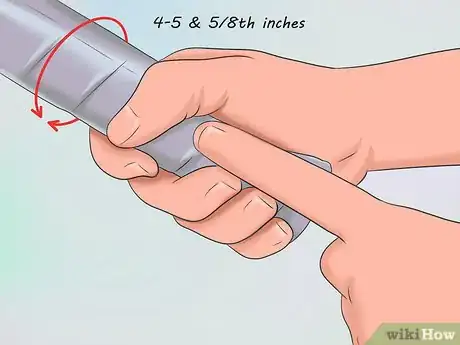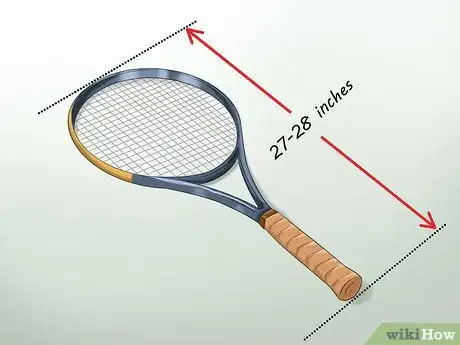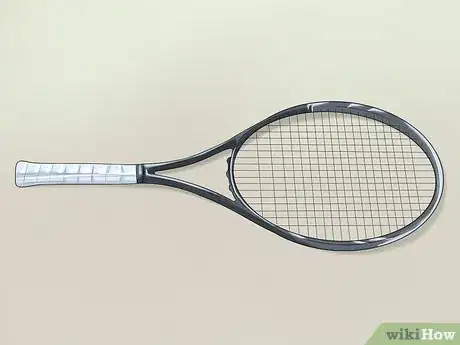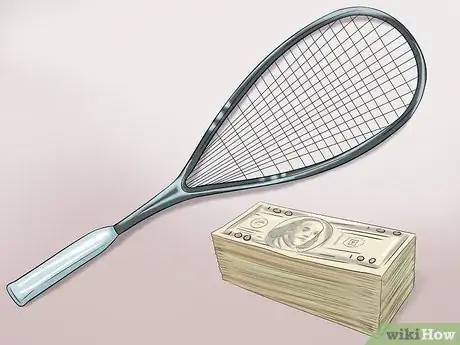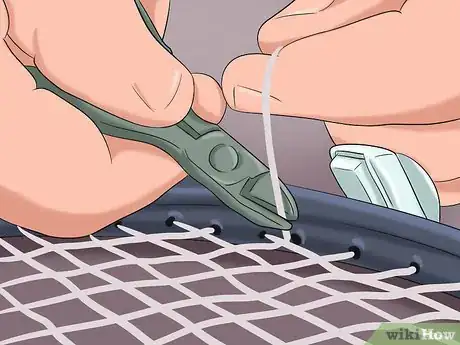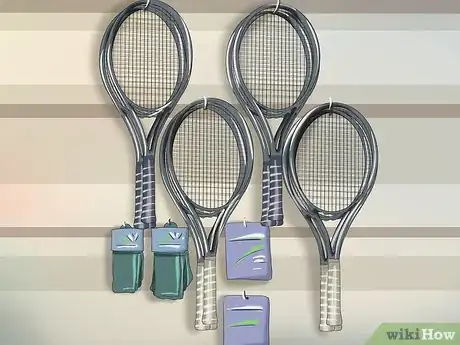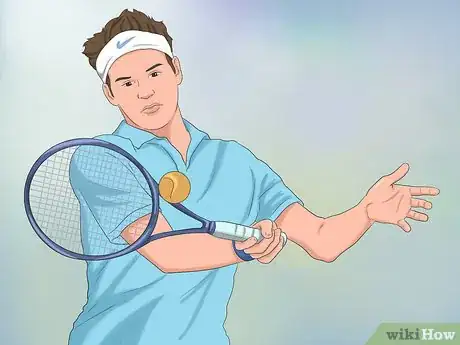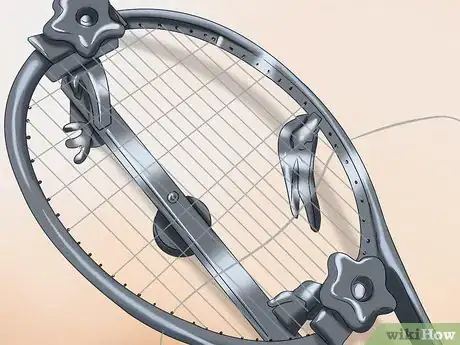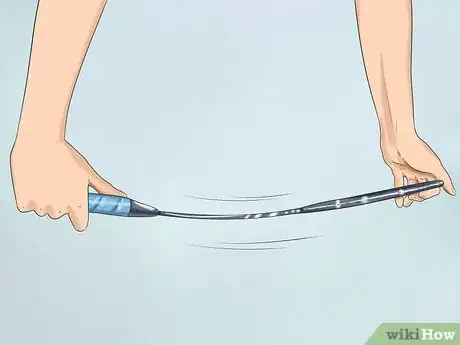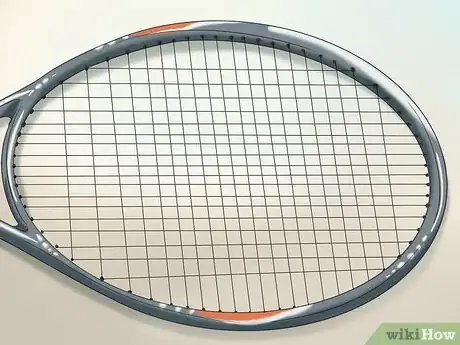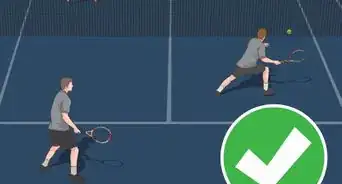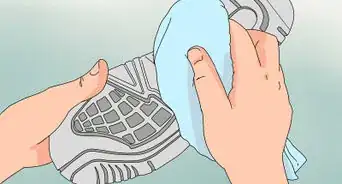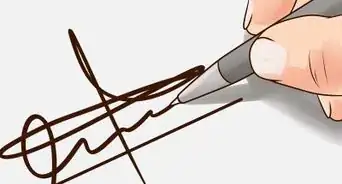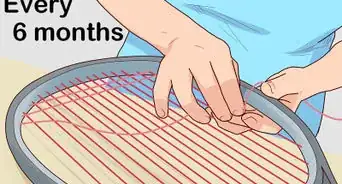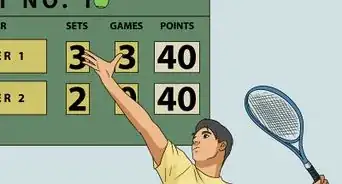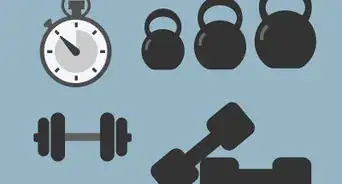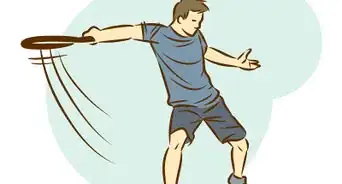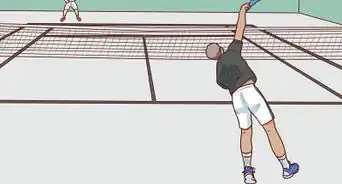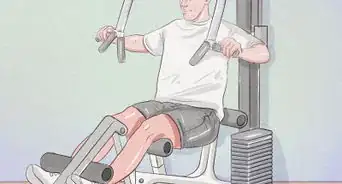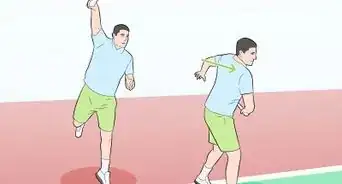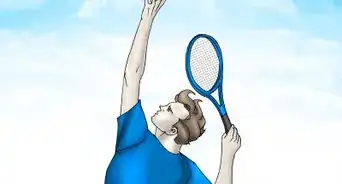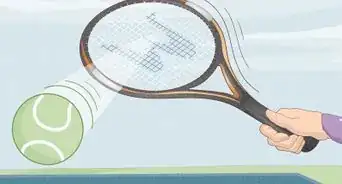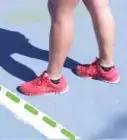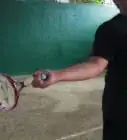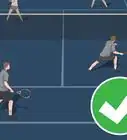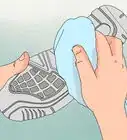This article was co-authored by Peter Fryer. Peter Fryer is a tennis writer and coach based in Derry Northern Ireland. He completed his professional teaching tennis qualification shortly after finishing university and has been teaching tennis for over 13 years. Peter began Love Tennis Blog in 2010 and contributes to the BBC and national media outlets.
wikiHow marks an article as reader-approved once it receives enough positive feedback. This article received 28 testimonials and 100% of readers who voted found it helpful, earning it our reader-approved status.
This article has been viewed 836,999 times.
Whether you're a beginner hitter or dreaming of becoming the next tennis champion, buying a tennis racquet will make a big difference for your game. All tennis racquets aren't created equally, and they all have their pros and cons. If you're thinking of playing tennis frequently, in any capacity, the right racquet is an investment worth researching.
Steps
Choosing the Right Racquet
-
1Measure for the proper grip size. Adult grips range from 4 to 4 & 5/8ths inches. To find yours, measure from the middle line in your palm to the top of your middle finger -- this is your grip size, in inches.[1]
- Another good rule of thumb is to hold the racquet in your dominant hand, like you would hold it to play. Slide the index finger of the opposite hand in between the tips of your fingers and the base of your palm on the racquet. If there isn't enough room for your index finger, the racquet grip is too small.
- If there is a lot of extra room, the racquet grip is too large.
- If you're between two sizes, choose the smaller one because you can always increase the circumference by adding an overgrip tape (a soft, padded, cloth-like tape wrapped around the grip).[2]
-
2Choose a normal, 27-inch long racquet unless you want the added power of extended length racquets. The traditional length of racquet is about 27 to 28 inches (68.6 to 71.1 cm), but you can get longer racquets of up to 29 inches (73.7 cm). The longer the length of the racquet, the greater the leverage on a swing, therefore giving more power to a shot.
- The trade-off, however, is that longer racquets are a little less maneuverable and difficult to aim.
- Beginners should start with a normal, 27" racquet.
Advertisement -
3Know the three major styles of tennis racquets. Depending on your needs, skill level, and style of play, you'll need a different racquet to reach your full potential. The three most common styles are:
- Power/Game Improvement Racquets: Characterized by large heads, longer style, and light weight, these are mostly for beginners-intermediate players or anyone who wants a little more power on their shot.
- Tweener Racquets: This well-balanced racquet is designed for all levels of skill and offer a good balance of power, control, and maneuverability.
- Control/Player's Racquets: The professional design, these racquets have small heads designed for maximum control. The player adds in their own power to the shot. They can be long or short, and are generally heavier than other racquets.[3]
-
4Buy a large, head-balanced racquet if you are a beginner. If you're starting to play tennis you want a forgiving racquet that allows for plenty of power without over-swinging. Choose a grip that fits you well and aim for a racquet near the following specs:
- Head Size: 106-118 square inches.
- Length: 27"
- Weight: Lightweight, 9-10oz
- Balance: Head-heavy, balanced towards the top.[4]
-
5Purchase a less powerful racquet if you are big, athletic, or already a powerful hitter. Even some beginners find the big, head-heavy rackets too much for them, especially if they are naturally athletic and powerful. The best way to adjust is to shrink the head size you purchase, leaving the other specs the same. A light, head-heavy racquet might still be desirable for control purposes when you're starting out.[5]
-
6Know the differences in racquet material when buying. Most racquets are made from graphite because it is light-weight and powerful, making it perfect for any beginner. Other racquets suitable for beginners are made from aluminum or titanium, as these provide good power and comfort when hitting. Boron or Kevlar racquets are the lightest on the market, but they're also quite stiff and thus less forgiving on mistakes.
- Beginners should stick to aluminum or graphite, but the material choice is also less important than if the racquet feels comfortable in your hands and if it suits your price range.
- Aluminum is the cheapest racket, and they are usually heavy. However, they are also sturdy and dependable.
- Boron, kevlar, and carbon fiber rackets are often much more expensive than their graphite counterparts.
-
7Test out a few racquets before buying. Take test swings and serves in the store and note how the racquet feels in your hand. Try and sample a broad variety of racquets when you first start looking -- from long and large power racquets to a few on the smaller end. For the best results, ask a few friends if you can sample their racquets next time you are on the court, and actually hit a few balls around to see what fits you best. Everyone's swing and style is a little different, which is why there are so many different types of racquet on the market.
Understanding Racquet Specifications
-
1Know that a larger head size transfers more power to the ball. The bigger the head, the more power you put on the ball (if everything else -- racket length, swing, etc.-- stays consistent). This is one of the biggest choices you'll make when picking a racquet, as more power frequently leads to less control. Do you typically over hit the ball, or do you want a little more power without altering your swing? Check your current head size and adjust accordingly.
- Oversized and large heads are usually 106-118 square inches, but they can get as big as 120-30 square inches for power racquets.
- Smaller control racquets usually have a head size around 85-94 square inches.
- For beginners, shoot for something closer to 100 square inches or above.[6]
-
2Choose head-heavy racquets for added power and stability. Head heavy racquets are best for baseline play and beginners and are usually found on power racquets. They are slightly weighted up near the top, and this makes them slightly less maneuverable. Intermediate and advanced players usually prefer a head-light or balanced racquet.
- If you go for a lot of net play, try out a head-light racquet for its increased maneuverability.
- If you're unsure what to get, or play a varied style of tennis, get a balanced racquet, which evenly distributes its weight.[7]
-
3Consider your stringing pattern. The racquet itself is not the only thing that affects your play. The way the strings are aligned, in either an open or closed ("dense") stringing, will affect your power, control, and spin:
- Open stringing offers more spin, which means you can hit the ball harder with top spin. These strings, however, are more likely to break.
- Closed/Dense stringing offers more control for shot placement, and are better for beginners.[8]
-
4Use flexible racquets for more power but less control. A racquet flexibility is given by a rating from 0-100, with 100 being the stiffest option available. Most racquets fall between 45-75 on the scale:
- Lower numbers indicate more control and spin, less power, and a more comfortable feel.
- Higher numbers indicate more power, but also more vibrations in the racquet. Some beginners actually feel like they get more control on them because the lack of bend makes them feel a little more natural.
-
5Check the beam width, the triangle under the racquet head, to gauge power potential. A bigger beam width means you'll have more power on the racquet. This makes sense, since bigger beams are needed for larger racquets, but even control racquets have variable beam widths that affect how hard you can hit the ball.
- For beginners, a good starting width would be between 23-27mm.[9]
Expert Q&A
Did you know you can get expert answers for this article?
Unlock expert answers by supporting wikiHow
-
QuestionWhat is the best tennis racquet for intermediate players?
 Peter FryerPeter Fryer is a tennis writer and coach based in Derry Northern Ireland. He completed his professional teaching tennis qualification shortly after finishing university and has been teaching tennis for over 13 years. Peter began Love Tennis Blog in 2010 and contributes to the BBC and national media outlets.
Peter FryerPeter Fryer is a tennis writer and coach based in Derry Northern Ireland. He completed his professional teaching tennis qualification shortly after finishing university and has been teaching tennis for over 13 years. Peter began Love Tennis Blog in 2010 and contributes to the BBC and national media outlets.
Tennis Instructor Test out a few racquets to find the one that's the best fit for you. Most good pro shops allow you to test their racquets for a small fee. Racquets are tailored to different types of players. For example, you might be a baseliner who relies on powerful groundstrokes, or you may be a serve-and-volleyer who requires a racquet that provides control and touch at the net. Finding the correct racquet will give you confidence to play the game your way.
Test out a few racquets to find the one that's the best fit for you. Most good pro shops allow you to test their racquets for a small fee. Racquets are tailored to different types of players. For example, you might be a baseliner who relies on powerful groundstrokes, or you may be a serve-and-volleyer who requires a racquet that provides control and touch at the net. Finding the correct racquet will give you confidence to play the game your way. -
QuestionHow do I choose the right tennis racquet?
 Peter FryerPeter Fryer is a tennis writer and coach based in Derry Northern Ireland. He completed his professional teaching tennis qualification shortly after finishing university and has been teaching tennis for over 13 years. Peter began Love Tennis Blog in 2010 and contributes to the BBC and national media outlets.
Peter FryerPeter Fryer is a tennis writer and coach based in Derry Northern Ireland. He completed his professional teaching tennis qualification shortly after finishing university and has been teaching tennis for over 13 years. Peter began Love Tennis Blog in 2010 and contributes to the BBC and national media outlets.
Tennis Instructor Consider the weight of the racquet. The weight of a racquet really impacts how it will play. They range from around 250g-340g. Lighter racquets are generally much easier to swing and they have larger head sizes, so they're suitable for a learning player or someone who has reduced mobility in their arm. Heavier racquets, weighing 300g or more, have a smaller head and sweet spot. Also, consider the grip size to ensure you can hold the racquet comfortably. Racquets come in different grip sizes that range from 4 1/8 to 4 3/4 inches. In Europe, these are called G1—G5. Your grip size is determined by the size of your hands. If you select too small of a grip, it could affect your ability to play the game, and it might even cause tennis elbow.
Consider the weight of the racquet. The weight of a racquet really impacts how it will play. They range from around 250g-340g. Lighter racquets are generally much easier to swing and they have larger head sizes, so they're suitable for a learning player or someone who has reduced mobility in their arm. Heavier racquets, weighing 300g or more, have a smaller head and sweet spot. Also, consider the grip size to ensure you can hold the racquet comfortably. Racquets come in different grip sizes that range from 4 1/8 to 4 3/4 inches. In Europe, these are called G1—G5. Your grip size is determined by the size of your hands. If you select too small of a grip, it could affect your ability to play the game, and it might even cause tennis elbow. -
QuestionWhat is the best tennis racket for beginners?
 Peter FryerPeter Fryer is a tennis writer and coach based in Derry Northern Ireland. He completed his professional teaching tennis qualification shortly after finishing university and has been teaching tennis for over 13 years. Peter began Love Tennis Blog in 2010 and contributes to the BBC and national media outlets.
Peter FryerPeter Fryer is a tennis writer and coach based in Derry Northern Ireland. He completed his professional teaching tennis qualification shortly after finishing university and has been teaching tennis for over 13 years. Peter began Love Tennis Blog in 2010 and contributes to the BBC and national media outlets.
Tennis Instructor The head size affects your play. Many recreational or learning players tend to go toward racquets with a bigger head size, and that's perfectly fine. You want to give yourself as good an opportunity as you can to hit the ball. The downside to these larger-headed racquets is that they aren't as maneuverable as one with a smaller head, so you might not have as much control.
The head size affects your play. Many recreational or learning players tend to go toward racquets with a bigger head size, and that's perfectly fine. You want to give yourself as good an opportunity as you can to hit the ball. The downside to these larger-headed racquets is that they aren't as maneuverable as one with a smaller head, so you might not have as much control.
Warnings
- Choosing the wrong racquet can increase the likelihood of common tennis-related maladies, such as tennis elbow (lateral epicondylitis) and stress on the ulnar collateral ligament.⧼thumbs_response⧽
References
- ↑ http://www.tennis-warehouse.com/LC/Gripsize.html
- ↑ http://www.tennis-warehouse.com/LC/Gripsize.html
- ↑ http://www.tennisnuts.com/shop/tennis/tennis-rackets/racket-guides/how-to-choose-a-tennis-racket.html
- ↑ https://www.myactivesg.com/sports/tennis/how-to-play/tennis-equipment/how-to-choose-your-tennis-racket
- ↑ http://www.tennisnuts.com/shop/tennis/tennis-rackets/racket-guides/how-to-choose-a-tennis-racket.html
- ↑ http://www.tennisexpress.com/info/choosing-a-tennis-racquet.cfm
- ↑ http://www.midwestsports.com/helpracquets/a/helpracquets/
- ↑ http://www.tennis-warehouse.com/LC/SelectingRacquet.html
- ↑ http://www.tennisnuts.com/shop/tennis/tennis-rackets/racket-guides/how-to-choose-a-tennis-racket.html
About This Article
To choose a tennis racquet, look for a racquet made out of graphite or aluminum if you're a beginner, as these are both lightweight materials. Additionally, choose a power racquet with a large head to hit the ball harder. Once your game improves, try a tweener racquet for additional control. Next, decide between open string racquets, which put more spin on the ball, and racquets with dense strings, which give you more accuracy. You should also test out a few racquets by taking test swings and serves in the store to see how they feel in your hand. For tips on how to understand racquet specifications and how to measure your grip length, read on!
